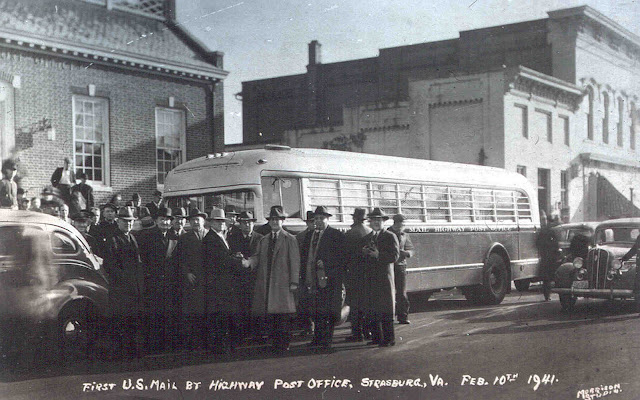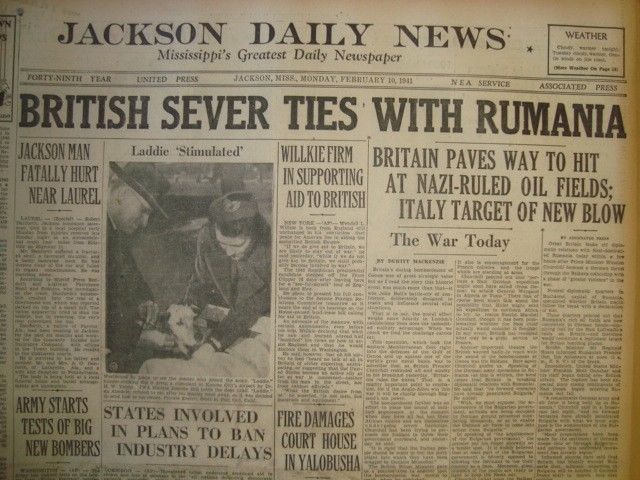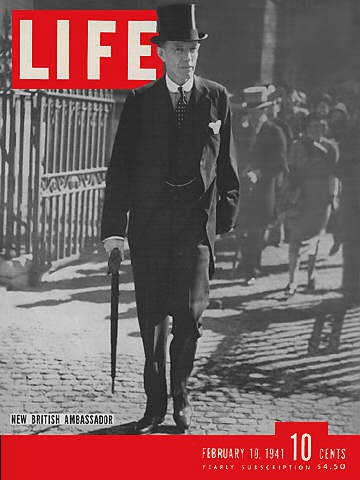Monday 10 February 1941
 |
| Romanian IAR-80 fighters. |
East African Campaign: After a one-day pause, the British Indian troops at Keren resume their attacks. Today, they focus on the left side of the Dongolaas Gorge and don't attack the right side at all. The 3/1st Punjab Regiment attacks Brig's Peak and Sanchil Peak next to it. As on their previous attack, the Indian troops are vulnerable to artillery and small-arms fire both at the mountain and on the approaches from the Cameron Ridge. The fighting is fluid and seesaws throughout the day, with both sides claiming the peak at different times. The day ends with the Indian troops managing to maintain two platoons situated partway up the heights. The two battalions involved, the 3/1st Punjab and the 4/11 Sikhs, lose 123 and 100+ casualties, respectively.
In Italian Somaliland, British General Cunningham (brother of Admiral Cunningham) opens Operation Canvas. This is an assault across the Juba River. The RAF raids Afmadu in Italian Somaliland. In Eritrea, the Indian 7th Infantry Brigade captures Mersa Tadai (on the Red Sea Coast).
At Kismayo, Somalia, the Axis authorities can see the writing on the wall regarding the approaching British troops. Eight ships make a break for it after dark, trying to escape to more secure ports. The Royal Navy, however, is patrolling offshore with improvised Force T. Heavy cruiser HMS Hawkins captures:
- 3809-ton Italian freighter Adria
- 5490-ton Italian freighter Savoia
- 5644-ton Italian freighter Erminia Mazzella
- 5594-ton Italian freighter Manon
- 7515-ton Italian freighter Leonardo da Vinci
2315-ton Italian freighter Duca Degli Abruzzi and 2699 ton Italian freighter Somalia are the only two of the eight ships that make good their escapes. They make it to Diego Suarez.
 |
| HMAS Sydney at Circular Quay, Sydney Harbor, 10 February 1941 (Sydney Morning Herald). |
There is a Circus Raid on Dunkirk and a Roadstead operation on shipping off Calais. Both are by six Blenheim bombers escorted by heavy fighter escorts.
There are reports of a Luftwaffe air raid on Iceland. The only slight activity takes place over England, with a few bombs dropped on East Anglia.
Werner Mölders claims his 56th victory.
Battle of the Atlantic: The weather remains rough. Ice in the North sea damages U-147, sending it back to Cuxhaven for repairs, while Royal Navy 109-ton drifter Boy Alan is involved in a collision and sinks in the Thames Estuary. The frigid weather makes surviving sinkings extremely unlikely unless conditions are just right, and two ships sink today with no survivors.
U-37 (Kptlt. Asmus Nicolai Clausen) follows up its two sinkings east of the Azores on the 9th with another one today. Today, it torpedoes and sinks 1473 ton British freighter Brandenburg in Convoy HG 53. All 23 crew onboard perish, along with 30 survivors of the Courland which the Brandenburg had picked up on the 9th after U-37 sank it as well. Convoy escort sloop Deptford launches an attack on U-37, but the submarine gets away.
U-52 (Kptlt. Otto Salman) torpedoes and sinks 3364-ton British freighter Canford Chine about 306 km southwest of Rockall in the Northwest Approaches. There are no survivors from the 35-man crew.
The Luftwaffe bombs and damages 6869-ton British freighter Benmacdhui in the North Sea off Hembsy Beach. The ship manages to make it to Tees on her own.
German raider Kormoran concludes its three-day meeting with supply ship Nordmark in the mid-Atlantic off the Cape Verde Islands. Captain Detmers takes his ship south. On this journey, Detmers receives a signal from Berlin notifying him that the Kormoran has been awarded two First Class Iron Crosses and 50 Second Class Iron Crosses, to be awarded to whomsoever he chooses.
Convoy BS 15 departs from Suez, Convoy SL 65 and SLS 65 depart from Freetown.--
Royal Navy destroyer HMS Blackmore is laid down.
US submarine USS Growler is laid down.
 |
| Highway Post Office bus #1, Strasburg, Virginia, 10 February 1941. This is a new "mail on wheels" Highway Post Office bus route of the US Post Office (Postal Museum). |
The British troops of Operation Colossus arrive over the Italian drop zone at 21:42. The paratroopers from the first five planes land quite near or in the drop zone. However, the sixth plane for some reason misses the drop zone completely and ultimately drops its six paratroopers in a valley two miles from the aqueduct about two hours later. Ordinarily, this might not have been a problem, given planned redundancy; however, this final plane just happens to be carrying Royal Engineer sappers and their demolition equipment. The commander of the force, Major T.A.G. Pritchard, forms a hedgehog around the bridge, but at first determines that he has insufficient explosions to demolish the aqueduct (which is found to be constructed, not of brick, but of reinforced concrete). However, he picks a particularly vulnerable spot around the western pier and manages to blow up both the aqueduct and another nearby bridge over the Ginestra River.
At this point, the Commandos split up into three groups and head for pickup on the coast. A local farmer spots the Pritchard group, and local carabinieri (police) soon arrives and arrests them. Another commando group tries to bluff their way out by claiming to be Germans, but the carabinieri round them up, too. All of the groups wind up as POWs, and the Italian translator with them is given to the Blackshirts, tortured, and executed. To add to the mission's later reputation as a fiasco, the submarine sent to pick the commandos up, HMS Triumph, must rescue the crew of a crashed Whitley (conducting a diversionary raid at Foggia airport) and would have been unavailable for the pick-up anyway because of security concerns that its location had been identified.
The operation is a technical success and a strategic failure. The aqueduct is repaired quickly, and the Italian base is unaffected because it has other short-term water supplies. The best result of Operation Colossus for the British is that the military learns that more planning is necessary for the troops after they are on the ground, not just on how to get them to the target.
Having stopped at Palermo, Sicily, the convoy carrying the very first elements of what will become the Afrikakorps (DAK) departs for the final leg to Tripoli. This is by far the most hazardous portion of the convoy route, both due to the presence of the Royal Navy but also because of mines and RAF aerial surveillance. The transports carrying the 5th Light Division troops should dock in Tripolitania on the 11th.
Australian Prime Minister Robert Menzies, whose troops have been a key component in the victories achieved over the Italians in the recent Operation Compass, has lunch with British Middle East Commander General Archibald Wavell. He records the following conclusions in his private diary:
(a) Tripoli probably not worthwhileThe mention of Tripoli is significant, because, if Wavell knew that the Germans were on the verge of landing there, he might not think it was "not worthwhile."
(b) Aggregation principle for AIF good, but must not be too rigid - e.g., guarding Canal or tackling Dodecanese. Difficult to find a front which will occupy entire Corps.
(c) Victory at Keren and Massawa would end East African campaign
(d) Thinks we should consider forming a Second Corps Headquarters.
In Libya, General O'Connor's XIII Corps continues clearing the region from Benghazi to El Agheila. O'Connor is seeking permission to proceed further west and south to Tripolitania and has sent a liaison officer to Cairo to get permission from Wavell.
Royal Navy Force H, which successfully bombarded Genoa on the 9th, arrives back at Gibraltar.
The RAF raids Colato, Rhodes.
Today marks Malta's 300th air raid of the war. It is a minor raid by one bomber at 18:40, with the aircraft dropping bombs at Hal Far airfield and Kalafrana.
 |
| Jackson Daily News, 10 February 1941. |
Anglo/US Relations: President Roosevelt's personal envoy to London Harry Hopkins boards a plane to fly back to Washington.
Japanese/Thai Relations: The Japanese are "mediating" continuing negotiations between the Thais and the Vichy French to conclude their border war in Indochina. They send four cruisers ( IJN Suzuya, IJN Mikuma, IJN Mogami, and IJN Kumano) to Bangkok to "show the flag." This is Operation S, a not-very-subtle show of support for the Thais and an effort to pressure the French into a weak negotiating posture.
US Military: The 104th Automatic Weapons Battalion is activated at Birmingham, Alabama. Iowa National Guard unit 133rd Infantry Regiment is inducted into the US Army as the 34th Infantry Division.
Romanian Military: Deliveries of the first 20 home-grown IAR 80 fighters begin today to operational units of the 8th Fighter Group. The aircraft uses a licensed Gnome-Rhône 14K II Mistral Major engine (870 hp (650 kW) IAR K14-III C32 engine, switched to the 960 hp (716 kW) K14-IV C32 engine for the 21st through 50th versions).
Coincidentally, a Bf 109 arrives at Brasov today for purposes of testing a DB 601 1175hp engine on the IAR 80. Romanian pilots have complained that the engine in the plane is underpowered, and it also is in short supply. However, ultimately the DB 601 engine (removed from the Messerschmitt and transplanted into the IAR 80) is found to cause vibrations in flight and is not used.
US Government: While the US House of Representatives has passed the Lend-Lease bill, the Senate is still considering it. Merwin K. Hart, a founder of the New York State Economic Council, testifies. He states that the Lend-Lease bill likely would lead the country into war and create an authoritarian regime in the United States.
Dutch Homefront: In occupied Amsterdam, tensions are brewing. There are street clashes between SA street thugs and Jewish supporters. Daily resistance paper "Nieuwsbrief van Pieter’t Hoen," changes its name to "Het Parool."
 |
| Life Magazine, 10 February 1941. |
February 1941
February 1, 1941: US Military Reorganization
February 2, 1941: Wehrmacht Supermen
February 3, 1941: World Will Hold Its Breath
February 4, 1941: USO Forms
February 5, 1941: Hitler Thanks Irish Woman
February 6, 1941: Operation Sunflower
February 7, 1941: Fox Killed in the Open
February 8, 1941: Lend Lease Passes House
February 9, 1941: Give Us The Tools
February 10, 1941: Operation Colossus
February 11, 1941: Afrika Korps
February 12, 1941: Rommel in Africa
February 13, 1941: Operation Composition
February 14, 1941: Nomura in Washington
February 15, 1941: Churchill's Warning
February 16, 1941: Operation Adolphus
February 17, 1941: Invade Ireland?
February 18, 1941: Panzerwaffe Upgrade
February 19, 1941: Three Nights Blitz
February 20, 1941: Prien's Farewell
February 21, 1941: Swansea Blitz Ends
February 22, 1941: Amsterdam Pogrom
February 23, 1941: OB-288 Convoy Destruction
February 24, 1941: Okuda Spies
February 25, 1941: Mogadishu Taken
February 26, 1941: OB-290 Convoy Destruction
February 27, 1941: Operation Abstention
February 28, 1941: Ariets Warns Stalin
2020
No comments:
Post a Comment